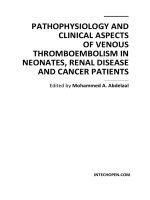Renal Failure – The Facts Edited by Momir Polenakovic docx
Bạn đang xem bản rút gọn của tài liệu. Xem và tải ngay bản đầy đủ của tài liệu tại đây (11.87 MB, 282 trang )
RENAL FAILURE
– THE FACTS
Edited by Momir Polenakovic
Renal Failure – The Facts
Edited by Momir Polenakovic
Published by InTech
Janeza Trdine 9, 51000 Rijeka, Croatia
Copyright © 2012 InTech
All chapters are Open Access distributed under the Creative Commons Attribution 3.0
license, which allows users to download, copy and build upon published articles even for
commercial purposes, as long as the author and publisher are properly credited, which
ensures maximum dissemination and a wider impact of our publications. After this work
has been published by InTech, authors have the right to republish it, in whole or part, in
any publication of which they are the author, and to make other personal use of the
work. Any republication, referencing or personal use of the work must explicitly identify
the original source.
As for readers, this license allows users to download, copy and build upon published
chapters even for commercial purposes, as long as the author and publisher are properly
credited, which ensures maximum dissemination and a wider impact of our publications.
Notice
Statements and opinions expressed in the chapters are these of the individual contributors
and not necessarily those of the editors or publisher. No responsibility is accepted for the
accuracy of information contained in the published chapters. The publisher assumes no
responsibility for any damage or injury to persons or property arising out of the use of any
materials, instructions, methods or ideas contained in the book.
Publishing Process Manager Maja Bozicevic
Technical Editor Teodora Smiljanic
Cover Designer InTech Design Team
First published May, 2012
Printed in Croatia
A free online edition of this book is available at www.intechopen.com
Additional hard copies can be obtained from
Renal Failure – The Facts, Edited by Momir Polenakovic
p. cm.
ISBN 978-953-51-0630-2
Contents
Preface IX
Chapter 1 Risk Factors for Renal Failure:
From Infancy to Adulthood 1
Silvio Maringhini, Vitalba Azzolina,
Rosa Cusumano and Ciro Corrado
Chapter 2 The Pathogenesis of Acute Kidney Injury 17
Nicholas A. Barrett and Marlies Ostermann
Chapter 3 Oxidative and Nitrosative Stress
in the Ischemic Acute Renal Failure 25
Miguel G. Salom, B. Bonacasa, F. Rodríguez and F. J. Fenoy
Chapter 4 Immunological and Molecular Mechanisms
Leading to Fibrosis:
Origin of Renal Myofibroblasts 47
Leonóra Himer, Erna Sziksz,
Tivadar Tulassay and Ádám Vannay
Chapter 5 Effects of Maternal Renal Dysfunction
on Fetal Development 81
Toshiya Okada, Yoko Kitano-Amahori, Masaki Mino,
Tomohiro Kondo, Ai Takeshita and Ken-Takeshi Kusakabe
Chapter 6 Proteomic Biomarkers
for the Early Detection of Acute Kidney Injury 105
Stefan Herget-Rosenthal, Jochen Metzger, Amaya Albalat,
Vasiliki Bitsika and Harald Mischak
Chapter 7 Sepsis and Dialysis Disequilibrium Syndrome 123
Nissar Shaikh
Chapter 8 Acute Kidney Injury Following Cardiac Surgery:
Prevention, Diagnosis, and Management 129
Emmanuel Moss and Yoan Lamarche
VI Contents
Chapter 9 Acute Kidney Injury
Induced by Snake and Arthropod Venoms 157
Markus Berger, Maria Aparecida Ribeiro Vieira
and Jorge Almeida Guimarães
Chapter 10 Contrast Nephropathy: A Paradigm
for Cardiorenal Interactions in Clinical Practice 187
Michele Meschi, Simona Detrenis,
Laura Bianchi and Alberto Caiazza
Chapter 11 The Outcome of HIV-Positive Patients Admitted
to Intensive Care Units with Acute Kidney Injury 197
J. D. Nel and M. R. Moosa
Chapter 12 Management of Heparin-Induced Thrombocytopenia
in Uremic Patients with Hemodialysis 203
Takefumi Matsuo
Chapter 13 The Psychological Impact of Hemodialysis
on Patients with Chronic Renal Failure 217
Liang-Jen Wang and Chih-Ken Chen
Chapter 14 Renal Replacement Therapy in Uremic Diabetic Patients –
Experience from The Republic of Macedonia 237
Momir H. Polenakovic
Preface
The book Renal Failure – The Facts consists of some facts about diagnosis,
etiopathogenis and treatment of acute and chronic renal failure. Acute, as well as
chronic renal failure is great medical problems and their treatment is a burden for the
budget of each government.
Acute kidney injury (AKI), previously termed acute renal failure, is a frequent clinical
condition in critically ill patients especially, in intensive care units (ICU). Its incidence
varies from 1-7 % of all hospitalized patients to 30-50 % of patients in ICU. Irrespective
of the progress being made in the understanding of the pathophysiology of AKI and
its underlying processes and the advances in critical care medicine, mortality rate
associated with AKI remains high especially in ICU patients at more than 50 %. In
addition, a significant proportion of surviving patients (20 %) develops CKD and
end-stage renal disease, requiring chronic renal replacement therapy. Long-term
outcome is worse for patients after recovery from AKI, further impacting health care
cost and quality of life. In developing countries, AKI is more common in young and
pediatric patients, while in developed countries elderly patients are predominant. In
critically ill patients the most common cause of AKI is sepsis, accounting for 50 % of
all cases.
Chronic kidney disease (CKD) is a long-term condition which can arise from the
damage to the kidneys from a variety of diseases. Patients with CKD are frequently
asymptomatic until the disease is advanced. In 2002 the K/DOQI Clinical Practice
Guidelines provided a definition of CKD which is now widely used around the world.
Generally, cross-sectional population studies in a number of countries suggests an
overall prevalence of CKD 1-5 of >10%. CKD appears to be an independent and
significant risk factor for progressive cardio vascular disease (CVD). CVD accounts for
≈ 50% of the death in patients with CKD.
The purpose of the chapters is to present some important issues of diagnosis and
causes of AKI, as well as caused by snakes and arthropods, after cardiac surgery,
as well as some therapeutic achievements in AKI. Well presented are the
psychological condition in patients on haemodialysis, as well as the treatment of
diabetic uremics.
X Preface
The book is aimed at clinicians with a special interest in nephrology (including
consultants and specialist trainees in nephrology), but it should also prove to be a
valuable resource for any generalists who encounter a nephrological problems in their
day-to-day practice.
Momir H. Polenakovic
Macedonian Academy of Sciences and Arts
Republic of Macedonia
1
Risk Factors for Renal Failure:
From Infancy to Adulthood
Silvio Maringhini
*
, Vitalba Azzolina, Rosa Cusumano and Ciro Corrado
Pediatric Nephrology Unit. U.O.C. Nefrologia Pediatrica, Ospedale dei Bambini
“G. Di Cristina” A.R.N.A.S. “Civico, Di Cristina e Benfratelli”, Palermo
Italy
1. Introduction
Abnormal development of the kidneys and the urinary tract, genetic factors, acquired
disease during infancy and childhood, wrong dietary habits and environmental factors may
produce renal damage and cause renal insufficiency which may become clinically evident in
adulthood. Prevention of renal insufficiency relies on early recognition of risk factors
recognizable in childhood.
2. Risk factors for kidney disease
The incidence and progression of renal injury vary substantially among individuals who are
at risk for kidney disease. Variability of risk for the occurrence and progression of Chronic
Kidney Disease (CKD) suggests that biologically relevant characteristics may influence the
occurrence or course of the renal disease. Prediction of increased risk of occurrence or
progression of CKD may enable clinicians to identify individuals who may benefit from
closer supervision of care or more intensive disease modifying interventions. Risk factors
can be used to define at risk population that can be targeted for education and early
intervention programs. These factors include familiarity of CKD, genetic factors, nephron
number, low birth weight, perinatal programming, nutritional setting, hypertension and
congenital abnormalities of the kidney and urinary tract (CAKUT) (Table 1).
Risk factors for Chronic Kidney Disease detectable in childhood
Family history of hypertension and kidney disease
Low birth weight
Perinatal kidney injury
Congenital injury
Hematuria and/or proteinuria
Urinary tract infection
High blood pressure
Overweight
Table 1.
*
Corresponding Author
Renal Failure – The Facts
2
2.1 Familiarity of CKD
A family history of kidney disease (FAM) has been associated with an increased risk of end
stage renal disease (ESRD). In a recent report FAM was identified as an independent risk
factor for ESRD [1]. In 1998 Lei at al in large population case-control study found a
correlation between FAM and ESRD, especially in patients with a strong FAM with an odds
ratio of 7.4.[2]. In the same year Freedman et al. found a high prevalence (20%) of FAM in
dialysis patients. The prevalence decreased with age, was higher among African-Americans
than Caucasians [3]. Satko et al documented a three- to nine-fold greater risk of ESRD in
individuals with a FAM of ESRD. He noted a marked racial variation in the familial
aggregation of kidney disease, with high rates in African American [4]. Other authors
documented a stronger association in blacks than whites, indicating specific ethnic
differences [5-6]. Recently in USA it has been proposed the ESRD Networks Family History
Project as a national CKD surveillance system for patients with stage 5 CKD to identify
relatives of incident patients with ESRD who are 2 to 3 times as likely to have ESRD [7].
2.2 Genetic factors
It is well known that genetic factors play a crucial role in CKD and ESRD [8] More recently,
genome-wide association studies have yielded highly promising results suggesting a
number of potential candidate genes and genomic regions that may contribute to the
pathogenesis of CKD [8]. For example, common variants in the UMOD and PRKAG2 genes
are associated with risk of chronic kidney disease [9]. Genome-wide association studies of
CKD are beginning to define the genomic architecture of kidney disease and will impact our
understanding of how genetic variation influences susceptibility to this condition.
The expression of genes is defined by their epigenetic state; prenatal factors may produce
stable changes in expression of genes as documented in several studies. DNA methylation
[10], oxidative stress in response to low protein diet in pregnancy [11], telomere length [12]
which is regulated by telomerase enzymatic activity during fetal life have been implicated in
fetal renal development and disesase, excess glucocorticoids in early life can permanently
alter tissue glucocorticoid signalling. All these studies show that the mechanism involved in
developmental programming are likely epigenetic rather than due to DNA sequence
mutations. It is important to note that changes produced by epigenetic factors, differently
from genetic changes, are potentially reversible.
2.3 Nephron number
The number of nephrons in humans ranges from 250.000 to 2.5 million with an average of
about 1 million per kidney; this high variability is due to various causes. Nephrogenesis
ends at 36 weeks of gestation, for this reason premature newborns may have a reduced
nephron number; the same condition is observed in patients with kidney disease and in
older patients due to age–related glomerulosclerosis. In the last 20 years many authors
analyzed the association between nephron number and onset of renal disease later in life;
most of these studies have been conducted in animals since it is difficult to determinate the
number of glomeruli as measure of nephrons’ number in humans. Nyengaard and Bendtsen
performed in 1992 the first study that calculated the number of glomeruli in the kidneys of 37
Danes obtained at autopsy; they found a significant negative correlation between glomerular
number and age [13]. Successively Keller et al. documented a significant reduced number of
Risk Factors for Renal Failure: From Infancy to Adulthood
3
glomeruli in patients with hypertension compared to those who were normotensive [14]. More
recently Zhang et al have documented a wide 4.5-fold variability in the number of glomeruli in
children younger than 3 months ranging from 246,181 to 1,106,062 [15].
2.4 Prematurity and low birth weight
Low birth weight (LBW) is defined by the World Health Organization as a birth weight of
<2500 g. Intrauterine growth retardation (IUGR) is defined as weight below the tenth decile
for birth weight.
Fetal growth is conditioned by multiple factors which include the composition of maternal
body, alimentary habits during pregnancy, transport of nutrients through the placenta and
others. The final consequence of the alteration of this factors determinate a fetal-growth
reduction. The IUGR can be related to maternal undernutrition and/or placental insufficiency
[16]. Placental insufficiency, usually associated with preeclampsia and maternal cardiovascular
risk factors, is due to poor placentation. Maternal malnutrition is often related to wromg
dietaty composition more than total calorie intake. In rats Langley-Evans et al have
demonstrated that even short periods of maternal protein restriction during gestation in rats
are associated with LBW and subsequent hypertension [17]. In humans, increased protein
turnover at 18 weeks of gestation is associated with increased length of babies at birth [18].
In humans, the causes of LBW are multifactorial: demographic factors, socio-economics
status, poor maternal weight especially during pregnancy, shorter maternal height, maternal
gestational weight gain below 7 kg, maternal hypertension, chronic infections, glucose
intolerance or DM during pregnancy, maternal smoking or alcohol abuse, genetics, etc.
Irving et al demonstrated that premature children, independently of birth weight, have an
high risk of cardiovascular disease in adult age, thus making it very difficult to separate the
effects of gestational age and birth weight [19]. However, the growth retardation for a given
gestational age has greater relevance than the effect of prematurity on subsequent
cardiovascular disease in adult age, as was demonstrated by Whincup et al [20]. The
correlation between low birth weight and number of nephrons was reported by Ma˜ nalich et
al.; they observed a mean reduction of 20% of the nephrons in children with LBW. [21]. The
same observations was obtained by Hughson et al who documented that LBW is accompanied
by fewer large-volume nephrons than in individuals with normal birth weights [22].
Multiple animal models have demonstrated the association of LBW with later development
of hypertension. The link between adult hypertension and LBW in these animal models
appears to be mediated by a congenital nephron deficit showed by Vehaskari et al [23]. In
humans many studies have reported higher blood pressures in those who had been of LBW.
Barker et al first reported the association between hypertension in adult life and birth
weight [24]. A study in Swedish children by Nilsson et al found a significant relation
between birth weight and systolic arterial pressure [25]. Similar observations was done by
Huxley et al [26]. In several studies, the relationship was more significant in girls than boys
[27] and in woman than man [28]. The relationship between birth weight and blood pressure
is also increased by accelerated postnatal growth [29] . Hoy et al in 1999 reported an
association between low birth weight and CKD, observing increased rates of
microalbuminuria in Australian Aborigines, a population with high rates of low birth
weight [30]. In the last years many studies have documented that low birth weights
contribute to high rates of early-onset chronic renal failure in United States patients, in
Renal Failure – The Facts
4
ducth adolescents, and in young and adult Norwegians [31-34]. In a meta-analysis, White et
al. found that the combined odds ratio (OR) for risk of albuminuria associated with low
birth weight was 1.81 (1.19–2.77) and for ESRD 1.58 (1.33-1.88). They concluded that existing
data indicate that low birth weight is associated with subsequent risk of CKD [35]. Recently,
Hodgin et al. described an association between focal segmental glomerular sclerosis (FSGS)
and prematurity and very low birth weight [36].
2.5 Perinatal programming
The processes of development and maturation of organs occur continuously throughout the
pre- and postnatal periods. Intrauterine growth is generally regulated by intrinsic growth
potential, genetic endowment, and support of nutrients from the materno-uteroplacental
unit. However, during the postnatal period growth may be affected by environmental
conditions and genetic background. The environmental impact on a genetic program
determine the renal perinatal programming of each individual. The term “fetal
programming” describes the structural and functional adaptive phenomena in response to
critical periods during fetal life and early postnatal growth. Perinatal programming may
produce a reduced nephron number leading to the development of chronic kidney disease
[37]. Several environmental stressors may act on specific genetic programming of low
nephron number. The time at which an adverse factor is involved during gestation before
completion of nephrogenesis may affect kidney growth [38]. A history of LBW and IUGR,
vitamin A deficiency, urinary tract malformations, administration of nephrotoxic drugs may
interact to increase potential nephron damage. Maternal nutrition may have an important
influence on renal programming [39]. In rats, a restricted supply of nutrients to the
mother during nephrogenesis contributed to a reduced number of glomeruli per kidney,
activation of the renin-angiotensin system, glomerular enlargement, and hypertension in
adult life [40].
2.6 Hypertension
Maternal hypertension is a significant risk factor for LBW and is more prevalent among
black than white women, making the population-attributable risk of LBW highest among
babies of hypertensive black mothers [41]. Taittonen et al found that a history of mother’s
high blood pressure during pregnancy predicted future blood pressure more eminently than
birth weight [42].
Hypertension is one of the major causes of renal insufficiency in adults. It has been proven
that children with higher blood pressure develop hypertension, cardiovascular diseases and
renal failure as adults. The first study that found a correlation of adult blood pressure with
childhood blood pressure was the Muscatine study in 1989 [43]. Successively the Bogalusa
Heart study documented that childhood blood pressure predicts adult microalbuminuria in
African Americans, but not in whites [44]. In the same group of patients it was found that
diastolic blood pressure in children and increased blood pressure variability in children are
significantly correlated with adult hypertension [45-47].
2.7 Obesity
Obesity is a recognized risk factor for end-stage renal disease (ESRD) [48]. The increased
blood pressure associated with obesity is accompanied by impaired pressure natriuresis.
Risk Factors for Renal Failure: From Infancy to Adulthood
5
The volume expansion is related to activation of the sympathetic nervous system and renin-
angiotensin system. Obesity also causes renal vasodilation and glomerular hyperfiltration as
compensatory mechanisms. In the long-term, these changes, along with the increased
systemic arterial pressure, causes glomerular injury. Moreover obesity causes an increase of
urinary protein excretion and gradual loss of nephron function that worsens with time and
exacerbates hypertension. Overweight and obesity are associated with the metabolic
syndrome and type II diabetes, a major cause of kidney disease; in obese patients renal
failure progresses much more rapidly [49].
2.8 CAKUT
Congenital abnormalities of the kidney and urinary tract in most cases apparently are not
associated with a reduced glomerular filtration rate (GFR) but the renal reserve may be
reduced to the point that an increased demand by a growing body produces a drop in GFR.
A recent review of Sanna-Cherchi et al evaluated the renal outcome in patients with CAKUT
[50]. They found that patients with solitar kidney, usually considered to have good
prognosis, have a higher risk for dialysis with an HR of 2.43 compared to patients with
hypodysplasia or multicystic kidney. These data are in contrast to precedent studies that
found a good prognosis of renal function in patients with unilateral agenesis [51]. In the last
years many authors have looked for a correlation of CAKUT with genetic disorders [52].
2.9 Hematuria and proteinuria
Iseki et al in 1996 in a community mass screening found that proteinuria was the most
useful predictor of ESRD (adjusted odds ratio 14.9, 95% confidence interval 10.9 to 20.2), and
the next most potent predictor was hematuria (adjusted odds ratio 2.30, 95% confidence
interval 1.62 to 3.28) [53]. In a recent paper Vivante A et Al found an increase of incidence of
ESRD in patients (aged 16 to 25 year) with persistent asymptomatic isolated microscopic
hematuria [54]. In 2011 a meta-analysis found that albuminuria is a risk factor for all-cause
and cardiovascular mortality in high-risk populations [55].
2.10 Urinary tract infections and vesico-ureteral reflux
Vesicoureteral reflux (VUR) is a frequent condition in pediatric patients. Approximately
1/3 of patients who have had a urinary tract infection (UTI) have VUR and 9–20% of
patients with prenatal hydronephrosis have VUR [56]. Children affected by VUR may
develop reflux nephropathy (RN) and some of them chronic kidney disease (CKD). In a
recent review Brakeman identifies the principal risk factors of progression of VUR to CKD:
reduced glomerular filtration rate (GFR), bilateral VUR and/or renal scarring, grade V VUR,
proteinuria, and hypertension. [57]. Ardissino et al found an estimated risk of end stage
renal disease (ESRD) of 56% in italian children by age 20 years [58]
3. Evolution of renal damage
The pathogenesis of progressive renal functional deterioration is certainly multifactorial,
and the decline in glomerular filtration rate varies in groups of patients with different
nephropathies, but also in patients with the same disease. Some of these factors may be
modifiable, particularly in children, and therapeutic interventions may result in a reduced
Renal Failure – The Facts
6
rate of deterioration of renal function. The persistent deterioration of renal function may be
a result of repeated and chronic insults to the renal parenchyma leading to permanent
damage and/or to the adaptive hyperfiltration response of the kidney. The reduced
glomerular filtration area due to congenital or acquired nephron deficit, according with the
Brenner’s hypothesis of “glomerular hyperfiltration”, could expose to a higher risk of
cardiovascular and renal disease in adulthood since the increased workload produces
proteinuria with glomerulosclerosis, tubulointerstitial inflammation and fibrosis [59]. In
addition to hyperfiltration and proteinuria, there is evidence that chronic renal hypoxia
could be directly involved in the progression of CKD, particularly in progression of
tubulointerstitial fibrosis. Chronic renal hypoxia could be elicited by several factors such as
loss of peritubular capillaries (PTCs), decreased PTC flow, decreased nitric oxide production
and/or bioavailability and activation of the renin-angiotensin system. With regard to this,
Kang et al previously demonstrated that the inhibition of NOS accelerated renal damage in a
remnant kidney model by eliciting PTC loss [60]. Recent evidence suggests that overweight
and obesity play a role in renal-pressure natriuresis. Excessive weight gain increases renal
tubular reabsorption and impairs pressure natriuresis, in part, through activation of the
sympathetic and renin-angiotensin system as well as physical compression of the kidney.
With prolonged obesity, there are also structural changes in the kidney (including
enlargement of Bowman’s space, increased glomerular cell proliferation, increased
mesangial matrix, and thicker basement membranes, increased expression of glomerular
transforming growth factor) that eventually cause loss of nephron function, further
impairment of pressure natriuresis, and further increases in arterial pressure [61]. Finally, a
number of genetic factors (eg, single nucleotide polymorphisms and modifier genes) may
influence the immune response, inflammation, fibrosis, and atherosclerosis, possibly
contributing to accelerated progression of CKD [62]. With respect to specific genes,
apolipoprotein E (ApoE) polymorphisms may alter the risk of atherosclerotic disease, and
therefore progression of CKD. The ApoE epsilon-2 allele is associated with elevated
lipoprotein and triglyceride levels, whereas the ApoE epsilon-4 allele is associated with
elevated levels of high density lipoprotein and lower triglycerides. In a secondary analysis
of the Atherosclerosis Risk in Communities Study of 14,520 patients with a median follow-
up of 14 years, individuals with an ApoE epsilon-4 allele (present in 30 percent) had a 15
percent reduction in risk of progression of CKD compared to individuals with ApoE
epsilon-3 allele (present in 90 percent). The risk with the ApoE epsilon-2 allele was not
significantly different compared with ApoE epsilon-3 [63]. Gene expression profiles within
the kidney may help identify molecular prognostic factors in chronic renal disease. In the
future, genetic testing and molecular analysis of renal biopsy specimens (and/or urine) may
provide useful prognostic information.
The rate of progression to ESRD in childhood is inversely proportional to the baseline CrCl
at presentation. In addition, genetic, familial, or ethnic predisposition may influence the rate
of renal decline. As an example, African-Americans are more susceptible to CKD, and the
rate of progression of CKD is higher among African-American males than other ethnic
groups. The rate of progression of CKD is usually greatest during the two periods of rapid
growth, infancy and puberty, when the sudden increase in body mass results in a rise in the
filtration demands of the remaining nephrons [64]. Therefore children may have a normal
glomerular filtration rate which sharply reduces in young adulthood. These events place
increased demands upon the preexistent compromised kidney function. As a result, children
with CKD should be closely monitored during these two periods for an accelerated
Risk Factors for Renal Failure: From Infancy to Adulthood
7
progression of CKD. In addition to the increase in body mass, hormonal changes during
puberty may also contribute to the rapid decline in renal function seen in adolescence.
4. Causes of renal injury and renal failure in children
Genetic and environmental factors are traditionally considered causes of human disease.
Many genetic disorders may cause renal disease in childhood or in adults (Table 2) but also
prenatal factors may produce stable changes in expression of genes. Studies from diverse
populations suggest that fetal programming may be the origin of several intrauterine events
that ultimately manifests as overt disease such as hypertension, type 2 diabetes, obesity, and
chronic kidney disease (CKD) [65].
GENETIC KIDNEY DISEASE
Cystic disease
Polycistic Disease (ARPKD, ADPKD)
Tuberous Sclerosis
Von Hippel Lindau Syndrome
Glomerulocystic Disease
Medullary Cystic Disease (Nephronophthisis)
Glomerular Disease
Alport Syndrome
Family Focal Glomerulosclerosis
Congenital Nephrotic Syndrome
Nail-Patella Syndrome
Denys-Dash Syndrome
Tubular Disease
Dent Syndrome
Distal tubular acidosis
Lowe's syndrome
Fanconi Syndrome
Gitelman syndrome
Bartter syndrome
Table 2.
In addition to prenatal conditions, adverse postnatal events must be taken in consideration:
infections, drugs, trauma, systemic diseases etc. In fact, CKD in children, which has a much
lower prevalence than in adults, is the result of a heterogeneous group of disorders (Figure
1). Congenital disease accounts for almost 60 percent of CKD cases and includes obstructive
uropathy, renal hypoplasia, and renal dysplasia. Glomerular disorders are the second
largest cause of childhood CKD and are present in 7 to 17 percent of children with CKD.
Renal Failure – The Facts
8
Glomerular disease is more common in children greater than 12 years of age. Focal
segmental glomerulosclerosis (FSGS) is the most common glomerular disorder occurring in
9 percent of all CKD cases. Other causes account for approximately 25 percent of cases. In 18
percent of all cases of CKD, the underlying primary diagnosis is not identified (15 percent)
or is unknown (3 percent). Other more uncommon causes of CKD in children include
hemolytic-uremic syndrome, genetic disorders (eg, cystinosis, oxalosis, and hereditary
nephritis), and interstitial nephritis.
Fig. 1. FSGS: focal segmental glomerulosclerosis; GN: glomerulonephritis; Structural:
structural anomalies of the kidney and urinary tract.
Adapted from: NAPRTCS: 2007 Annual Report, Rockville, MD, EMMES, 2007. Available at
5. Prevention of renal diseases and kidney injury
Preventing renal impairment is an urgent challenge for medical practitioners. Several
studies indicate that earlier stages of CKD can be detected through laboratory testing, and
that early therapeutic interventions in the course of CKD are effective in slowing or
preventing the progression toward ESRD and its associated complications [66]. Pediatricians
and General Practioners should closely follow these infants, Health Care and Education
providers should prioritize programs to stress the importance of preventive care and
continuity of care especially for children of mothers with evidence of low propensity toward
health promotion.
The NKF-K/DOQI guidelines for CKD, reviewed in Kidney Disease Improving Global
Outcomes (KDIGO), recommend that all individuals should be assessed, as routine health
examinations, to determine the increased risk for developing CKD. Patients who are at risk
Structural
GN
FSGS
Other
Age, years
Etiology of CKD in pediatric patients, percent
Risk Factors for Renal Failure: From Infancy to Adulthood
9
for developing CKD should be screened for hematuria with a urinalysis and with a urine
test for proteinuria and a blood test for creatinine to estimate GFR. Depending upon the
presence of particular risk factors, additional testing such as renal ultrasonography may be
required, for example in patients with a family history of polycystic kidney disease. A
formidable task for paediatricians is to prevent renal diseases that may develop in adult life.
In order to achieve such goal, they should identify children at risk, counsel families to
minimize any further renal risk factors such as smoking, obesity, and hypertension, and, in
some cases together with a nephrologist, to institute pharmacologic therapy [67].
Strict blood pressure control has been shown to slow the progression of kidney disease and
reduce the risk of cardiovascular disease. The National High Blood Pressure Education
Program Working Group (NHBPEP) established guidelines for the definition of normal and
elevated blood pressures (BP) in children by developing blood pressure percentiles based on
gender, age, and height [68]. Hypertension (HTN) is defined as either systolic and/or
diastolic BP ≥95th percentile measured upon three or more occasions. Therapy includes both
nonpharmacologic and pharmacologic interventions. Treatment should be initiated with
conservative measures such as weight reduction, exercise, and dietary salt reduction.
Pharmacologic therapy may be started in non responders; ACE inhibitors or angiotensin II
receptor blockers (ARBs), that are the preferred antihypertensive agents as they reduce
proteinuria and appear to be more beneficial in slowing the progression of CKD compared
to other agents in patients with CKD [69-70].
Additional interventions that have been studied in adults with CKD include dietary protein
restriction, lipid lowering therapy, and correction of anemia. However, results are
inconclusive with respect to the impact of these interventions upon delaying the progression
of CKD. In children, data have not shown a benefit of a low protein diet upon the
progression of kidney disease CKD [71]. The current consensus by pediatric nephrology
experts is to provide children with CKD the age appropriate recommended daily allowance
for protein.
6. Treatment
The management of patients with CKD varies upon the severity of CKD. In the early stage it
is important to treat reversible kidney dysfunction and prevent or slow the progression of
kidney disease. In advanced stages (Stage 3 to 5) the management is focused on preventing
and treating the complications of CKD, that include disorders of fluid and electrolytes, renal
osteodystrophy, anemia, hypertension, dyslipidemia, growth impairment. The most
common conditions with potentially recoverable kidney function are primarily due to
decreased kidney perfusion or to the administration of nephrotoxic agents. Kidney
hypoperfusion is produced by systemic hypotension, volume depletion from vomiting,
diarrhea, diuretic use, or bleeding, and the administration of drugs that lower the kidney
perfusion (such as nonsteroidal anti-inflammatory drugs, angiotensin converting enzyme
[ACE] inhibitors, angiotensin II receptor blockers [ARBs]). Common nephrotoxic drugs
include nonsteroidal anti-inflammatory agents, diagnostic agents (eg, radiographic contrast
materials), and others (eg, aminoglycosides, amphotericin B, cyclosporine, and tacrolimus).
The administration of such drugs, therefore, should be avoided or used with caution in
patients with underlying CKD, with the assistance of therapeutic drug level monitoring. [72]
Renal Failure – The Facts
10
6.1 CKD complications
Major Problems in children with CKD
• Water and sodium retection
• Hyperkalemia
• Metabolic acidosis
• Mineral metabolism and bone disease
• Anemia
• Nutrition
• Growth
Table 3.
6.1.1 Water and sodium retention
It’s present as GFR becomes severely decreased (ie, stages 4 and 5 disease), and it may result
in volume overload. In general, a combination of dietary sodium restriction and diuretic
therapy may correct the increased water balance. Dietary sodium intake should be
decreased to 2 to 3 g/day and diuretic therapy includes loop diuretics such as
furosemide given at a dose of 0.5 to 2 mg/kg per day [73].
6.1.2 Hyperkalemia
Hyperkalemia develops primarily because of inadequate potassium excretion due to a
reduced GFR. Other factors that can contribute to elevated potassium levels include a high
dietary potassium intake, metabolic acidosis, hypoaldosteronism (due in some cases to
administration of an ACE inhibitor or an ARB), or an impaired cellular uptake of potassium.
Management to prevent hyperkalemia in children with CKD consists in low potassium diet,
administration of a loop diuretic (eg, furosemide) to increase urinary potassium loss,
correction of acidosis with oral sodium bicarbonate [73].
6.1.3 Metabolic acidosis
Metabolic acidosis is characteristically present when the estimated GFR is less than 30
mL/min per 1.73 m2 (ie, stage 4 disease). Acidosis is associated with growth impairment
because the body utilizes bone buffering to bind some of the excess hydrogen ions. Current
guidelines by the K/DOQI working group are to maintain the serum bicarbonate level at or
above 22 mEq/L . Sodium bicarbonate therapy is started at 1 to 2 mEq/kg per day in two to
three divided doses, and the dose is titrated to the clinical target [74].
6.1.4 Mineral metabolism and bone disease
Alterations of mineral metabolism are an almost universal finding with progressive CKD
due to abnormalities in the metabolism of calcium, phosphate, vitamin D, and parathyroid
hormone (PTH) levels. If these abnormalities are not addressed, these changes result in
kidney bone disease, referred to as renal osteodystrophy. The management and prevention
of secondary hyperparathyroidism is complex and requires frequent monitoring and
adjustment of therapy. The initial step is to correct phosphate retention by dietary restriction
Risk Factors for Renal Failure: From Infancy to Adulthood
11
usually combined with either calcium-containing phosphate binders and/or sevelamer. The
KDOQI guidelines recommend that treatment with calcitriol should be started when the
serum 25-hydroxyvitamin D is <30 ng/mL (75 nmol/L), or when serum PTH is above the
target range [75]. In adults, calcimimetics have been increasingly used to suppress PTH
secretion and decrease the risk of hypercalcemia associated with calcitriol. These agents,
which increase the sensitivity of the calcium-sensing receptor (CaSR) in the parathyroid
gland to calcium, have not been adequately studied in the pediatric population.
6.1.5 Anemia
Anemia in CKD is due to reduced kidney erythropoietin production and generally develops
when the GFR is below 30 mL/min per 1.73 m2. The treatment of anemia in children with
CKD often includes iron supplementation and erythropoiesis stimulating agent (ESA). The
K/DOQI guidelines recommend a target Hgb between 11 and 12 g/dL based upon consensus
expert opinion. The initial ESA dose in older children not receiving dialysis is 80 to 120 u/kg
per week, administered in two to three divided doses. Children younger than five years of age
or children receiving dialysis frequently require higher doses (300 u/kg per week) [76-77].
6.1.6 Nutrition
Malnutrition is common in children with CKD because of poor appetite, decreased intestinal
absorption of nutrients, and metabolic acidosis. Attention to nutrition is critical as it affects
both the physical growth and neurocognitive development of children [78].
6.1.7 Growth
Growth failure has been long recognized in children with CKD. While the institution of
recombinant human growth hormone (rHuGH) therapy can have a profound effect on the
height velocity of children with CKD who are growing poorly, early recognition and
management of malnutrition, renal osteodystrophy, acid-base abnormalities and electrolyte
disturbances should take place prior to considering the institution of rHuGH. [79].
6.1.8 Renal replacement therapy
Once the estimated GFR declines to less than 30 mL/min per 1.73 m
2
(stage 4 CKD), it is
time to start preparing the child and the family for renal replacement therapy. The family
should be provided with information related to preemptive kidney transplantation,
peritoneal dialysis, and hemodialysis. As in adults, some form of renal replacement therapy
will generally be needed when the GFR falls below 15 mL/min per 1.73 m2 (stage 5 CKD).
However, renal replacement therapy is often initiated before children reach these levels.
7. References
[1] Hsu C, Iribarren C, McCulloch C.E., Darbinian J, Go A. S Risk factors for end stage
renal disease. Arch Intern Med 169 (4): 342-350, 2009
[2] Lei H.H, Perneger T.V., Klag M.J., Whelton P.K., Coresh J. Familial aggregation of renal
disease in a population-based case-control study. JASN 9 1270-1276, 1998
Renal Failure – The Facts
12
[3] Freedman BI, Soucie M, McClellan W.M.: Family history of End-Stage Renal Disease
among incident dialysis patients. J Am Soc Nephrol 8: 1942-1945, 1997.
[4] Satko SG, Freedman BI, Moossavi S. Genetic factors in end-stage renal disease. Kidney
Int Suppl. Apr;(94):S46-9, 2005.
[5] Freedman BI, Spray BI, Tuttle AB, Buckalew VM Ir: The familial risk of end-stage renal
disease in African Americans. Am J Kidney Dis 2 1: 387-393, 1993.
[6] Spray BI, Atassi NG, Tuttle AB, Freedman BI: Familial risk, age at onset, and cause of
end-stage renal disease in white Americans.J Am Soc Nephrol 5: 1806-1 8 10, 1999.
[7] McClellan W.M., Satko SG, Gladstone E, Krisher JO, Narva AS, Freedman BI.
Individuals with a family history of ESRD are a high-risk population for CKD:
implications for targeted surveillance and interventions activities. Am J Kidney Dis
53 (Suppl 3) 100-106, 2009
[8] O'Seaghdha CM, Fox CS. Genetics of chronic kidney disease. Nephron Clin
Pract.;118(1):55-63, 2011.
[9] Köttgen A. Genome-wide association studies in nephrology research. Am J Kidney Dis.
56(4):743-58), 2010.
[10] Dressler GR: Epigenetics, development, and the kidney. J Am Soc Nephrol; 19: 2060–
2067, 2008
[11] Mohn A, Chiavaroli V, Cerruto M, et al. Increased oxidative stress in prepubertal
children born small for gestational age. J Clin Endocrinol Metab; 92:1372–1378, 2007
[12] Nilsson PM, Lurbe E, Laurent S. The early life origins of vascular ageing and
cardiovascular risk: the EVA syndrome. J Hypertens. 26(6):1049-57, 2008
[13] Nyengaard JR, Bendtsen TF Glomerular number and size in relation to age, kidney
weight, and body surface in normal man. Anat Rec 232:194–201, 1992
[14] Keller G, Zimmer G, Mall G, Ritz E, Amann K. Nephron number in patients with
primary hypertension. N Engl J Med 348:101–108, 2003.
[15] Zhang Z, Quinlan J, Hoy W, Hughson MD, Lemire M, Hudson T, Hueber PA, Benjamin
A, Roy A, Pascuet E, Goodyer M, Raju C, Houghton F, Bertram J, Goodyer P. A
common RET variant is associated with reduced newborn kidney size and function.
J Am Soc Nephrol. 19(10):2027-34, 2008.
[16] Duggleby S, Jackson Aa: Relationship of maternal protein turnover and lean body mass
during pregnancy and birth. Clin Sci 101:65–72, 2001
[17] Langley-Evans Sc, Phillips Gj, Benediktsson R, et al: Protein intake in pregnancy,
placental glucocorticoid metabolism and the programming of hypertension in the
rat. Placenta. 17:169–172, 1996.
[18] Henriksen T, Clausen T: The fetal origins hypothesis: Placental insufficiency and
inheritance versus maternal malnutrition in well-nourished populations. Acta
Obstet Gynecol Scand 81:112– 114, 2002.
[19] Irving J, Belton NR, Elton RA, et al: Adult cardiovascular risk factors in premature
babies. Lancet 355:2135–2136, 2000.
[20] Whincup PH, Cook DG, Papacosta O: Do maternal and intrauterine risk factors
influence blood pressure in childhood? Arch Dis Child 67:1423–1429, 1992.
[21] Ma˜ Nalich R, Reyes L, Herrera M, et al: Relationship between weight at birth and
number and size of renal glomeruli in humans: A histomorphometric study.
Kidney Int 58:770–773, 2000.
Risk Factors for Renal Failure: From Infancy to Adulthood
13
[22] Hughson M, Farris Ab Iii, Douglas-Denton R, et al: Glomerular number and size in
autopsy kidneys: The relationship to birth weight. Kidney Int 63:2113–2122, 2003.
[23] Vehaskari Vm, Aviles Dh, Manning J: Prenatal programming of adult hypertension in
the rat. Kidney Int 59:238–245, 2001
[24] Barker Dj, Osmond C: Low birth weight and hypertension. BMJ 297:134–135, 1988.
[25] Nilsson Pm, Ostergren Po, Nyberg P, et al: LBW is associated with elevated systolic
blood pressure in adolescence: A prospective study of birth cohort of 149,378
Swedish boys. J Hypertens 15:1627–1631, 1997.
[26] Huxley Rr, Shiell Aw, Law Cm: The role of size at birth and postnatal catch-up growth
in determining systolic blood pressure: A systematic review of the literature. J
Hypertens 18:815–831, 2000.
[27] Whincup P, Cook D, Papacosta O, et al: Birth weight and blood pressure: Cross
sectional and longitudinal relations in childhood. BMJ 311:773–776, 1995.
[28] Andersson Sw, Lapidus L, Niklasson A, et al: Blood pressure and hypertension in
middle-aged women in relation to weight and length at birth: A follow-up study. J
Hypertens 18:1753–1761, 2000.
[29] Huxley Rr, Shiell Aw, Law Cm: The role of size at birth and postnatal catch-up growth
in determining systolic blood pressure: Asystematic review of the literature. J
Hypertens 18:815–831, 2000.
[30] Hoy WE, Rees M, Kile E, Mathews JD, Wang Z. A new dimension to the Barker
hypothesis: low birthweight and susceptibility to renal disease. Kidney Int 56:1072–
1077. 1999.
[31] Lackland DT, Bendall HE, Osmond C, Egan BM, Barker DJ. Low birth weights
contribute to high rates of early-onset chronic renal failure in the Southeastern
United States. Arch Intern Med 160:1472–1476, 2000.
[32] Keijzer-Veen MG, Schrevel M, Finken MJ, Dekker FW, Nauta J, Hille ET, Frölich M, van
der Heijden BJ, Dutch POPS-19 Collaborative Study Group. Microalbuminuria and
lower glomerular filtration rate at young adult age in subjects born very premature
and after intrauterine growth retardation. J Am Soc Nephrol 16:2762–2768, 2005.
[33] Hallan S, Euser AM, Irgens LM, Finken MJ, Holmen J, Dekker FW. Effect of
intrauterine growth restriction on kidney function at young adult age: the Nord
Trondelag Health (HUNT 2) Study. Am J Kidney Dis 51:10–20, 2008.
[34] Vikse BE, Irgens LM, Leivestad T, Hallan S, Iversen BM. Low birth weight increases
risk for end-stage renal disease. J Am Soc Nephrol 19:151–157, 2008.
[35] White SL, Perkovic V, Cass A, Chang CL, Poulter NR, SpectorT, Haysom L, Craig JC,
Salmi IA, Chadban SJ, Huxley RR. Is low birth weight an antecedent of CKD in
later life? A systematic review of observational studies. Am J Kidney Dis 54:248–
261, 2009.
[36] Hodgin JB, Rasoulpour M, Markowitz GS, D'Agati VD. Very low birth weight is a risk
factor for secondary focal segmental glomerulosclerosis. Clin J Am Soc Nephrol
4:71–76, 2009.
[37] Ingelfinger JR: Disparities in renal endowment: causes and consequences. Adv Chronic
Kidney Dis; 15: 107–114, 2008.
[38] Hotoura E, Argyropoulou M, Papadopoulou F, Giapros V, Drougia A, Nikolopoulos P,
Andronikou S: Kidney development in the first year of life in small-for-gestational
age preterm infants. Pediatr Radiol; 35:991–994, 2005.









